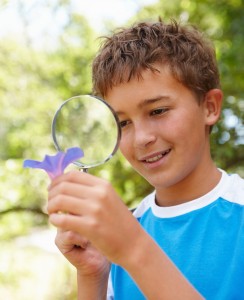 A group of 8 to 10 year old British schoolchildren just reported original findings in the journal Biology Letters, a peer-reviewed journal from Britain’s prestigious Royal Society. The research was born from their curiosity about nature: how do bees decide what flowers to get their nectar from? Might the color of the flowers matter? And how the flowers are arranged?
A group of 8 to 10 year old British schoolchildren just reported original findings in the journal Biology Letters, a peer-reviewed journal from Britain’s prestigious Royal Society. The research was born from their curiosity about nature: how do bees decide what flowers to get their nectar from? Might the color of the flowers matter? And how the flowers are arranged?
Designing a careful series of tests—in which some flowers had sugar water (like nectar) and others had salt water—the children from Blackawton Primary School, Devon, demonstrate that bees can use a combination of color and spatial cues to learn. As neatly detailed in the handwritten graphs and drawings with colored pencils, many bees figured out over time which flowers had the sugar water: the blue flowers surrounded by a ring of yellow flowers, or the yellow flowers surrounded by a ring of blue flowers—but never flowers on the outside.
The kid scientists went further than demonstrating the bees’ ability to learn complex patterns. They probed how the bees learned, and found that different bees used different rules to pick up on the same pattern. In addition to the findings themselves, the kids’ paper is filled with wonderful observations on why doing science is, as stated in the abstract, “cool and fun.”
As someone who just finished graduate school—studying how brain cells develop unique shapes that allow them to connect and communicate—I find their comments refreshing. They remind us what’s truly great about the scientific process.
Number one is definitely the thrill of trying what no one has tried before. “This experiment is important,” they explain, “because, as far as we know, no one in history (including adults) has done this experiment before.”
Another big draw is better understanding yourself and your world. “Scientists do experiments on monkeys, because they are similar to man, but bees could actually be close to man too,” the Blackawton children write. “…If bees are like us in some way, then understanding them could help us understand ourselves better.” (Reminds me of the fact that we can look at tiny worms or fruit flies to get valuable clues on how the circuits in our brains form.)
As this study shows, you don’t have to have a fancy laboratory with high tech equipment to do science. What you really need is curiosity—and the passion and persistence to carefully follow through on that curiosity.
To read a scientific commentary from New York University and University of Exeter researchers on the Blackawton study, click here.
To watch a video where kids talk about participating in medical research at Children’s, click here.







